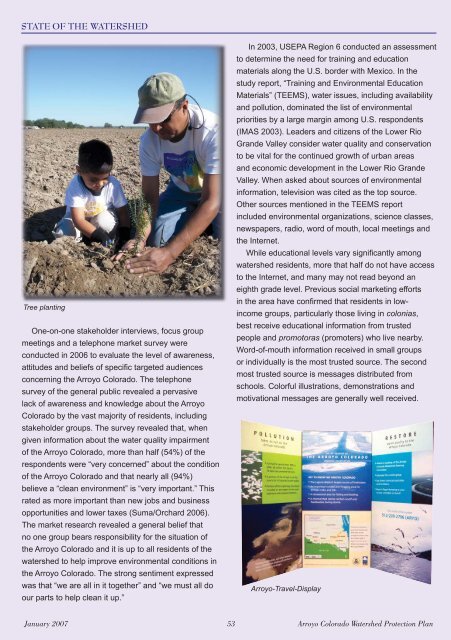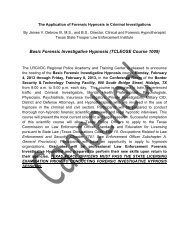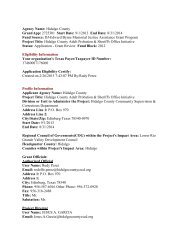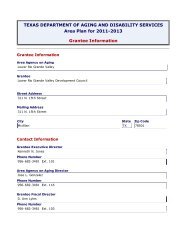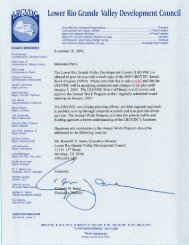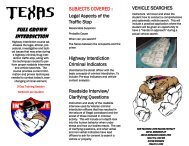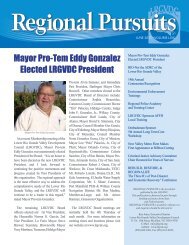Watershed Protection Plan - Lower Rio Grande Valley Development ...
Watershed Protection Plan - Lower Rio Grande Valley Development ...
Watershed Protection Plan - Lower Rio Grande Valley Development ...
You also want an ePaper? Increase the reach of your titles
YUMPU automatically turns print PDFs into web optimized ePapers that Google loves.
STATE OF THE WATERSHED<br />
Tree planting<br />
One-on-one stakeholder interviews, focus group<br />
meetings and a telephone market survey were<br />
conducted in 2006 to evaluate the level of awareness,<br />
attitudes and beliefs of specifi c targeted audiences<br />
concerning the Arroyo Colorado. The telephone<br />
survey of the general public revealed a pervasive<br />
lack of awareness and knowledge about the Arroyo<br />
Colorado by the vast majority of residents, including<br />
stakeholder groups. The survey revealed that, when<br />
given information about the water quality impairment<br />
of the Arroyo Colorado, more than half (54%) of the<br />
respondents were “very concerned” about the condition<br />
of the Arroyo Colorado and that nearly all (94%)<br />
believe a “clean environment” is “very important.” This<br />
rated as more important than new jobs and business<br />
opportunities and lower taxes (Suma/Orchard 2006).<br />
The market research revealed a general belief that<br />
no one group bears responsibility for the situation of<br />
the Arroyo Colorado and it is up to all residents of the<br />
watershed to help improve environmental conditions in<br />
the Arroyo Colorado. The strong sentiment expressed<br />
was that “we are all in it together” and “we must all do<br />
our parts to help clean it up.”<br />
In 2003, USEPA Region 6 conducted an assessment<br />
to determine the need for training and education<br />
materials along the U.S. border with Mexico. In the<br />
study report, “Training and Environmental Education<br />
Materials” (TEEMS), water issues, including availability<br />
and pollution, dominated the list of environmental<br />
priorities by a large margin among U.S. respondents<br />
(IMAS 2003). Leaders and citizens of the <strong>Lower</strong> <strong>Rio</strong><br />
<strong>Grande</strong> <strong>Valley</strong> consider water quality and conservation<br />
to be vital for the continued growth of urban areas<br />
and economic development in the <strong>Lower</strong> <strong>Rio</strong> <strong>Grande</strong><br />
<strong>Valley</strong>. When asked about sources of environmental<br />
information, television was cited as the top source.<br />
Other sources mentioned in the TEEMS report<br />
included environmental organizations, science classes,<br />
newspapers, radio, word of mouth, local meetings and<br />
the Internet.<br />
While educational levels vary signifi cantly among<br />
watershed residents, more that half do not have access<br />
to the Internet, and many may not read beyond an<br />
eighth grade level. Previous social marketing efforts<br />
in the area have confi rmed that residents in lowincome<br />
groups, particularly those living in colonias,<br />
best receive educational information from trusted<br />
people and promotoras (promoters) who live nearby.<br />
Word-of-mouth information received in small groups<br />
or individually is the most trusted source. The second<br />
most trusted source is messages distributed from<br />
schools. Colorful illustrations, demonstrations and<br />
motivational messages are generally well received.<br />
Arroyo-Travel-Display<br />
January 2007 53 Arroyo Colorado <strong>Watershed</strong> <strong>Protection</strong> <strong>Plan</strong>


